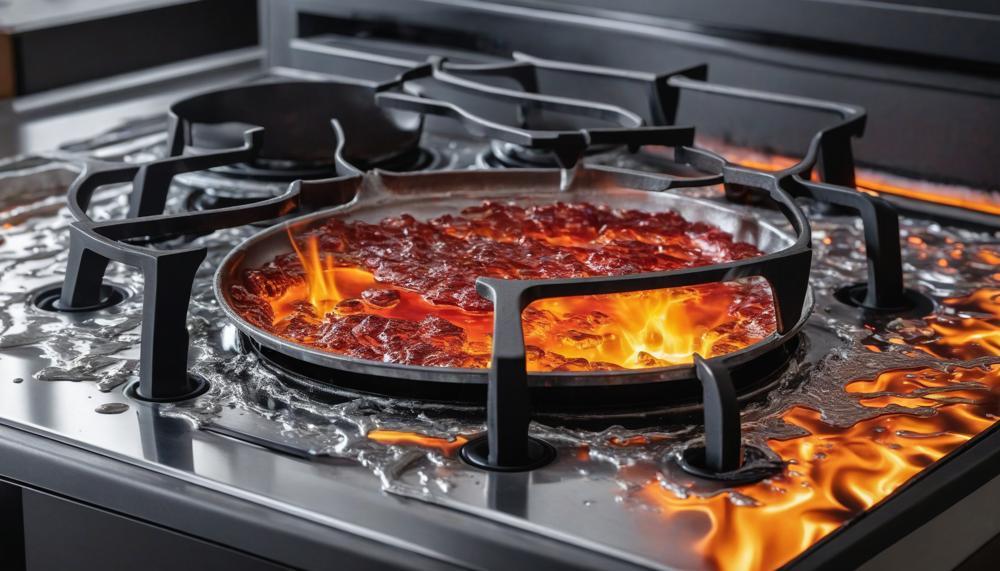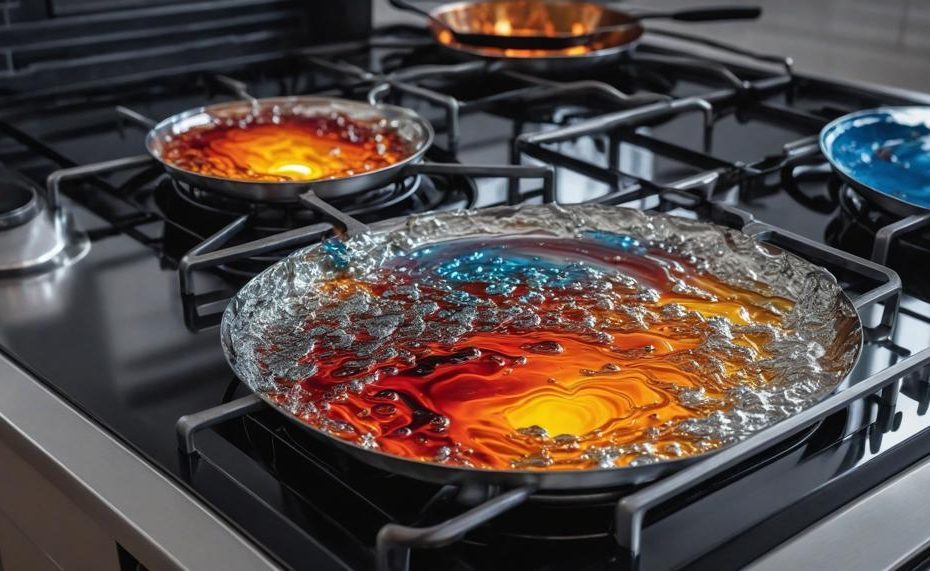Melting aluminum on a stove is a fascinating and achievable endeavor, allowing you to recycle materials right in your kitchen.
Aluminum has a melting point of 660 degrees Celsius, and with the right tools and patience, you can transform scrap pieces into molten metal for various projects.
This process involves using a crucible to contain the aluminum, cutting it into smaller pieces to aid in melting, and ensuring your stove can maintain the necessary heat.
Key Takeaways:
- Understand Aluminum’s Melting Point: Ensure your stove reaches 660 degrees Celsius.
- Use a Crucible: This container withstands high temperatures and holds the aluminum as it melts.
- Cut Aluminum into Small Pieces: Smaller pieces melt more efficiently and manageably.
- Maintain High Heat: Keep the stove at its maximum setting for consistent heat.
- Practice Patience: Melting aluminum takes time, so be patient and attentive.
Embarking on melting aluminum on a stove requires the right preparation and tools, but it’s a rewarding skill that offers practical and creative opportunities. Whether recycling aluminum cans or small scrap pieces, mastering this process can lead to exciting DIY projects and a deeper understanding of metalworking.
Contents
Step 1: The Furnace
To create a homemade furnace for melting aluminium on a stove, you’ll need specific materials and equipment to ensure safe and effective melting. Here’s a comprehensive list:
| Material | Quantity | Description |
| Steel Can | 1 | Use a large steel can (e.g., a coffee can) as the furnace body. It should be able to withstand high temperatures. |
| Plaster of Paris | 1 kg | Combined with sand to create a heat-resistant lining for the furnace. |
| Sand | 1 kg | Mix with plaster of Paris to form the furnace’s lining. |
| Crucible | 1 | A small, heat-resistant container (e.g., a graphite or steel crucible) to hold and melt the aluminium. |
| Aluminium | As needed | Pieces of aluminium or aluminium cans to melt. |
| Stovetop | 1 | A standard kitchen stovetop capable of reaching high temperatures (660°C). |
| Protective Gear | Set | Heat-resistant gloves, safety goggles, and an apron to ensure personal safety. |
| Mixing Container | 1 | For mixing plaster of Paris and sand. |
| Measuring Cup | 1 | To measure materials accurately. |
Instructions:
- Prepare the Furnace Body: Take the steel can and ensure it’s clean and free from any residues. This will serve as the main body of your furnace.
- Create the Lining: In a mixing container, combine equal parts of plaster of Paris and sand. Add water gradually and mix until you achieve a thick, consistent paste. Line the inside of the steel can with this mixture, ensuring it’s evenly spread to form a robust, heat-resistant layer.
- Set Up the Crucible: Place the crucible inside the lined steel can. This is where you’ll place the aluminium pieces for melting. Ensure the crucible is positioned securely.
- Heat the Furnace: Place the steel can furnace on your stovetop. Set the stove to its highest setting, aiming for a temperature around 660°C. Patience is key here; allow the furnace to preheat thoroughly.
- Melting Aluminium: Cut the aluminium into small, manageable pieces. Place these pieces into the crucible. Monitor the melting process carefully, ensuring you maintain a consistent high heat.
- Safety Measures: Always wear your protective gear while operating the furnace. Melting aluminium involves high temperatures, so safety should be your top priority.
By following these steps and using the right materials, you can successfully create a homemade furnace to melt aluminium on your stove.
Step 2: Crucible
The best type of crucible for melting aluminum on a stove is a steel crucible. Steel is known for its durability and ability to withstand high temperatures, making it ideal for the intense heat required to melt aluminum.
Explanation
Using a steel crucible offers several benefits:

- High Melting Point: Steel can endure the high temperatures needed to melt aluminum without deforming or breaking down. Aluminum melts at around 660°C (1220°F), and steel can withstand much higher temperatures, ensuring the crucible remains intact throughout the process.
- Strength and Durability: Steel crucibles are robust and can handle repeated use without significant wear and tear. This makes them a reliable choice for DIY enthusiasts who might melt aluminum frequently.
- Availability: Steel crucibles are relatively easy to find and can be sourced from hardware stores or online retailers. This makes them accessible for home projects.
- Safety: Using steel minimizes the risk of contamination in the melted aluminum, ensuring a cleaner end product. Additionally, steel’s strength reduces the likelihood of accidents due to crucible failure.
Practical Tips
- Preheat the Crucible: Gradually heat the steel crucible to avoid thermal shock, which can damage it.
- Use Protective Gear: Always wear appropriate safety gear, including gloves, goggles, and a heat-resistant apron, to protect yourself from splashes and intense heat.
- Monitor Temperature: Use a thermometer to ensure the aluminum reaches its melting point without overheating, which can cause oxidation or damage to the crucible.
Steel Crucible Options
| Type | Features | Where to Buy |
| Basic Steel Crucible | Affordable, durable, easy to use | Amazon UK |
| Refractory Steel Crucible | Enhanced heat resistance, suitable for higher temperatures | eBay UK |
| Graphite-Coated Steel Crucible | Reduces aluminum oxidation, improves purity | AliExpress |
Step 3: Tools
To safely and effectively melt aluminum on a stove, the essential tools and materials required include:
| Tool | Description | Importance |
| Stove | A stove capable of reaching 660 degrees Celsius (1220 degrees Fahrenheit). | Provides the necessary heat to melt aluminum. |
| Crucible | A heat-resistant container, preferably made of steel, to hold the aluminum during the melting process. | Ensures safety and contains the molten aluminum. |
| Protective Gear | Includes heat-resistant gloves, safety goggles, and an apron. | Protects against burns and splashes. |
| Small Pieces of Aluminum | Aluminum cut into manageable sizes for even melting. | Allows for quicker and more consistent melting. |
| Tongs | Long, heat-resistant tongs to handle the crucible. | Ensures safe handling of hot materials. |
| Thermometer | A high-temperature thermometer to monitor the heat. | Helps maintain the correct melting temperature. |
| Fire Extinguisher | A nearby fire extinguisher rated for metal fires. | Essential for safety in case of accidents. |
Step 4: Safety and Use
When melting aluminum on a stove, taking proper safety precautions is crucial to prevent accidents and ensure a smooth process. Here are some essential safety measures to keep in mind:
| Precaution | Description |
| Use Appropriate Equipment | Heat-resistant crucible, protective gear, and metal tongs are essential for safety. |
| Maintain a Safe Environment | Ensure proper ventilation, have a fire extinguisher nearby, and clear workspace of flammable materials. |
| Monitor Temperature | Use a thermometer to keep track of the temperature and control heating gradually. |
| Handle with Care | Pour molten aluminum slowly to prevent splashes and allow for proper cooling. |
| Emergency Preparedness | Keep a first aid kit and water source handy for immediate treatment of burns or injuries. |
By following these safety precautions, you can minimize the risks associated with melting aluminum on a stove.
Recommendations
Melting aluminum on a stove requires strict adherence to safety measures to prevent accidents and ensure a smooth process. Here are some crucial precautions:
| Precaution | Description | Action |
| Use Appropriate Equipment | Use a crucible and a high-temperature stove | Avoid regular pots; ensure stove capability |
| Maintain a Safe Environment | Clear workspace of flammable materials | Work in a ventilated area |
| Monitor Temperature | Use a thermometer to avoid overheating | Gradually increase heat |
| Handle with Care | Wear protective gear | Use heat-resistant gloves, goggles, and tongs |
| Be Prepared for Emergencies | Keep a fire extinguisher and have an evacuation plan | Use a metal fire-rated extinguisher; never use water |
These precautions ensure that melting aluminum on a stove is done safely and efficiently.
Conclusion
Embarking on the journey of melting aluminum on your stove is not only feasible but also an engaging way to recycle and create. The process revolves around achieving the aluminum’s melting point of 660 degrees Celsius, requiring a blend of the right tools, patience, and safety measures.
First, prepare a makeshift furnace using a steel can lined with a mixture of plaster of Paris and sand. This setup provides the necessary insulation to maintain high temperatures. A steel crucible, known for its durability and high melting point, is ideal for containing the aluminum. Cut the aluminum into small pieces to ensure efficient melting.
Place your furnace on the stove, setting it to its maximum heat. Patience is crucial here, as maintaining consistent high temperatures is key. Always wear protective gear, including heat-resistant gloves and safety goggles, to shield yourself from potential splashes and intense heat.
Safety cannot be overstated. Ensure proper ventilation and have a fire extinguisher rated for metal fires nearby. Use a thermometer to monitor the temperature, preventing overheating and ensuring a controlled melt.





